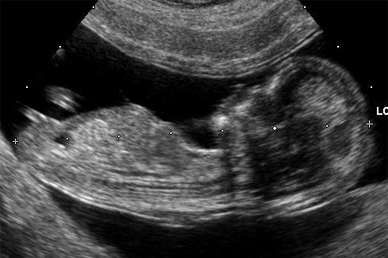Chemo and RT During Pregnancy Safe for Child
Exposure to chemo or radiotherapy has no long-term negative mental or cardiac effects on children exposed to these cancer treatments while in the womb, according to a study presented at the 2014 ESMO Congress.
Embryo at 12 weeks

Exposure to chemotherapy or radiotherapy has no long-term negative mental or cardiac effects on children exposed to these cancer treatments while in their mother’s womb, according to the results of two small studies presented at the ESMO 2014 Congress in Madrid.
According to lead author on both studies, Frederic Amant, MD, of University Hospitals Leuven in Belgium, these data should help to quell concerns about the potential effects of cancer treatment on unborn children. However, larger sample sizes and longer periods of follow-up will be needed to strengthen findings.
The first study (Abstract 267PD_PR) was a case control analysis evaluating mental development and cardiac functioning of children who were prenatally exposed to chemotherapy. Amant and colleagues recruited 38 children from the International Network for Cancer, Infertility, and Pregnancy registry and compared them with 38 control children. All were evaluated using the Bayley Scales of Infant Development and electro- or echocardiography. The median age at assessment was 20.5 months for the exposed children and 22 months for controls.
Children were exposed to an average of 4 cycles of chemotherapy; 61% of chemotherapy exposure was anthracyclines. The mean score of the Mental Development Index was 99.13 for children exposed to chemotherapy, and 101.47 for those not exposed, both considered to be within the normal range.
The researchers found no association between the number of cycles of exposure during pregnancy and scores on the mental development scale.
Commenting about these results in a prepared statement, Fedro Alessandro Peccatori, MD, director of the fertility and procreation unit at the European Institute of Oncology’s Division of Gynaecologic Oncology, who was not involved in the study, said, “This paper points to the very important issue of long-term safety of prenatal exposure to chemotherapy and reinforces the notion that chemotherapy during gestation does not endanger the fetus and her or his subsequent development. To further ameliorate neonatal outcome, a special effort should be made to prolong pregnancy duration, and stringent long-term follow-up should be pursued to confirm these findings.”
The second study (Abstract 49LBA_PR) assessed general health, cardiac, and neuropsychological outcomes of children who were exposed to radiotherapy while in utero. This study assessed 16 children and 10 adults exposed to antenatal radiotherapy. Children were assessed at 1.5, 3, 6, or 9 years using echocardiography, a neurological examination and other general health questionnaires. Estimated median maternal radiation exposure was 48 Gy and estimated fetal radiation was 91 mGy.
Results of the analyses showed that exposed children had neuropsychological, behavioral, and general health outcomes all considered to be within the normal range. In addition, no relationship was found between increasing fetal dose of radiation and cognitive outcomes. One child revealed a severe cognitive delay; however, other pregnancy-related complications were confounding factors.
“It’s a good feeling to know that research data can be implemented immediately into the clinic,” Amant said. “Our data will inform physicians and patients and help them to take decisions in a difficult situation.”